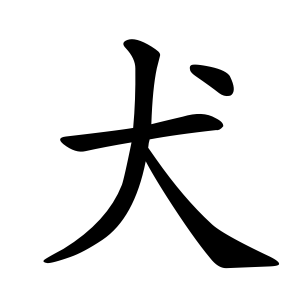犬
- dog;
Etymology
It is a pictograph based on the shape of a dog.
Usage in Korean
Besides 犬, there is also the character 狗 (dog, 구) that refers to a dog. Although their meanings are similar, there is a clear difference originally: 犬 referred to a large dog, while 狗 referred to a small dog or puppy. However, in modern Korea, this distinction has blurred, and since 狗 is used less often compared to 犬, the difference is almost lost.
In contrast, in Chinese, 犬 and 狗 are still clearly distinguished and commonly used differently. 犬 has a literary tone referring to dog species or subspecies, while 狗 is more commonly used in everyday speech to mean a dog. Also, 狗 can carry a somewhat derogatory connotation.
Alternative forms
Similar shape characters
Characters with 犬
9 strokes
17 strokes
犬
개
견
gae
gyeon
Kangxi radical:94
Strokes:4
Unicode:U+72AC
Cangjie input:
- 戈大 (IK)
Composition:
- ⿺ 大 丶
